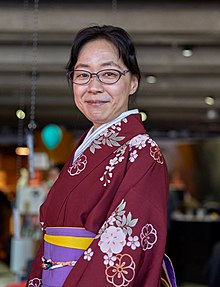Fumiyo Kōno
| Fumiyo Kōno (Fumiyo Kouno) | |
|---|---|
 Fumiyo Kōno, at the 2018 Stockholm International Comics Festival. | |
| Born | 28 September 1968 Nishi-ku, Hiroshima |
| Nationality | Japanese |
| Area(s) | manga artist and writer |
Notable works | Town of Evening Calm, Country of Cherry Blossoms In This Corner of the World |
Fumiyo Kōno (こうの 史代, Kōno Fumiyo, born 28 September 1968[1]), commonly romanized Fumiyo Kouno, is a Japanese manga artist from Nishi-ku, Hiroshima, known for her 2004 manga Town of Evening Calm, Country of Cherry Blossoms & her 2007 manga In This Corner of the World which got an anime film adaptation in 2016 by MAPPA.
Biography[]
She was born in Hiroshima in 1968 and began drawing manga when she was in junior high school.[2] She states that she began drawing manga because her parents would not often buy her manga.[3] Kōno studied science at Hiroshima University and moved to Tokyo, becoming an assistant to Katsuyuki Toda, Aki Morino, and Fumiko Tanigawa. Kōno made her commercial debut in 1995 with Machikado Hana Da Yori.[2] She feels that Osamu Tezuka and Fujiko Fujio were among her early influences, but then she was inspired by Sanpei Shirato's literary style and at present, she takes inspiration from Yu Takita's versatility.[3] She graduated from the University of the Air in 2001 with a major in Humanities.[2]
Works[]
Selected works. (Titles without an English version are given a literal translation enclosed in quotation marks.)
- Machikado Hana Da yori [Machikado hanadayori] (街角花だより, "Street-corner tidings of flowers"[n. 1]) (serialized 1995–1996 and 2002–2003, collected 2007, Futabasha), 1 volume[4]
- Pippira Nōto [Pippira chō] (ぴっぴら帳, Pippira Note) (serialized 1997–2004, collected 2009, Futabasha),[5][6] 2 volumes
- Kokko-san (こっこさん, "Mister Coco"[n. 2]) (serialized 1999–2001, collected 2005, Ohzora Shuppan)[9]
- Nagai Michi (長い道, "A long road"[n. 3]) (serialized 2001–2004, collected 2005, Futabasha)[10] (2009 reprint Futabasha)[11]
- Kappa no Neneko (かっぱのねね子, "Neneko the kappa-girl"[n. 4]) (script Akiho Kousaka, serialized 2001–2002, Fukuinkan Shoten Publishers)
- Town of Evening Calm, Country of Cherry Blossoms (夕凪の街 桜の国, Yūnagi no Machi, Sakura no Kuni) (2003–2004, serialized in Manga Action, Futabasha) (serialized 2002 and 2004, collected 2004, Futabasha)[12][13]
- San-san Roku [Sansanroku] (さんさん録, "San-san list [List for Sanpei]"[n. 5]) (serialized 2004–2006, collected 2006, Futabasha)[14][15]
- In This Corner of the World (この世界の片隅に, In a Corner of This World) (serialized 2007-2009, collected 2008–2009, Futabasha)[16][17][18]
Awards[]
- Kōno won the 2004 Japan Media Arts Festival Grand Prize (Manga Division) for Town of Evening Calm, Country of Cherry Blossoms[2]
- Kōno won the 2005 Tezuka Osamu Cultural Prize Creative Award for Town of Evening Calm, Country of Cherry Blossoms[1]
- Kōno won the 2009 Japan Media Arts Festival Excellence Prize (Manga Division) for Kono Sekai no Katasumi ni[19]
References[]
Notes[]
- ^ The title refers to a flower shop.
- ^ The titular "Kokko-san" is a parrot, equivalent of "Mister Coco".
- ^ The title could be rendered as "A long road" or "The long road", but the story is about a misfit couple who has "a long road" ahead of them. (Foreign translations have rendered it as "A long road" too.)
- ^ The title is literally "(girl name) the kappa", rendered using "kappa-girl".
- ^ The titular "San-san" is Sanpei as addressed by his departed wife. (Foreign translations have rendered it as "Diary for Sanpei" or just "For Sanpei".)
Citations[]
- ^ Jump up to: a b 朝日新聞手塚治虫文化賞 [Asahi Shimbun Tezuka Osamu Cultural Prize] (in Japanese). Asahi Shimbun. Archived from the original on 17 June 2005. Retrieved 23 February 2010.
- ^ Jump up to: a b c d "2004 Japan Media Arts Festival Manga Division Grand Prize YUNAGI NO MACHI SAKURA NO KUNI". Japan Media Arts Festival. Archived from the original on 16 January 2010. Retrieved 23 February 2010.
- ^ Jump up to: a b "Archived copy". Archived from the original on 27 September 2011. Retrieved 10 September 2011.CS1 maint: archived copy as title (link)
- ^ 街角花だより (in Japanese). Futabasha. Retrieved 24 February 2010.
- ^ コミック文庫)ぴっぴら帳 1 (in Japanese). Futabasha. Retrieved 24 February 2010.
- ^ コミック文庫)ぴっぴら帳 2 (in Japanese). Futabasha. Retrieved 24 February 2010.
- ^ ぴっぴら帳 1 (in Japanese). Futabasha. Retrieved 24 February 2010.
- ^ ぴっぴら帳 完結編 (in Japanese). Futabasha. Retrieved 24 February 2010.
- ^ こっこさん (in Japanese). Ohzora Shuppan. Retrieved 24 February 2010.
- ^ 長い道 (in Japanese). Futabasha. Retrieved 24 February 2010.
- ^ コミック文庫)長い道 (in Japanese). Futabasha. Retrieved 24 February 2010.
- ^ 夕凪の街 桜の国 (in Japanese). Futabasha. Retrieved 24 February 2010.
- ^ コミック文庫)夕凪の街 桜の国 (in Japanese). Futabasha. Retrieved 24 February 2010.
- ^ さんさん録 1 (in Japanese). Futabasha. Retrieved 24 February 2010.
- ^ さんさん録 2 (in Japanese). Futabasha. Retrieved 24 February 2010.
- ^ この世界の片隅に 上 (in Japanese). Futabasha. Retrieved 24 February 2010.
- ^ この世界の片隅に 下 (in Japanese). Futabasha. Retrieved 24 February 2010.
- ^ http://www.jpf.go.jp/JF_Contents/GetImage/img_pdf/jbn63.pdf?ContentNo=9&SubsystemNo=1&FileName=img_pdf/jbn63.pdf
- ^ "2009 Japan Media Arts Festival Manga Division Excellence Prize konosekai no katasumi ni". Japan Media Arts Festival. Archived from the original on 4 April 2010. Retrieved 23 February 2010.
External links[]
- Fumiyo Kōno at Anime News Network's encyclopedia
- 1968 births
- Living people
- Manga artists
- Women manga artists
- Manga artists from Hiroshima Prefecture
- Japanese female comics artists
- People from Hiroshima
- Hiroshima University alumni
- Female comics writers
- 20th-century Japanese women writers
- 21st-century Japanese women writers
